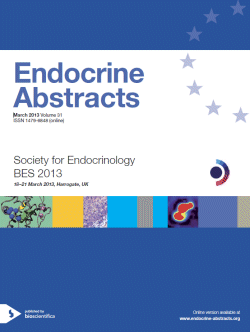Poster Presentations
Clinical biochemistry
ea0031p35 | Clinical biochemistry | SFEBES2013
A rapid and sensitive LC-MS/MS assay for the routine analysis of estradiol and estrone
ea0031p36 | Clinical biochemistry | SFEBES2013
The search for 3-Epi-25-hydroxy vitamin D
ea0031p37 | Clinical biochemistry | SFEBES2013
Plasma metanephrine analysis by online solid phase extraction LC-MS/MS
ea0031p38 | Clinical biochemistry | SFEBES2013
Development of an inductively coupled plasma-mass spectrometry method for measurement of urine iodine and assessment of iodine status in subclinical hypothyroidism
Jones Katie , Rogers Joanne , De Lloyd Anna , Rees Aled , Ludgate Marian , Evans Carol
ea0031p39 | Clinical biochemistry | SFEBES2013
Cross-reactivity of ten recombinant insulin preparations in the Abbott Architect Insulin immunoassay
Clarke Catriona , Shearing Catherine
ea0031p40 | Clinical biochemistry | SFEBES2013
HPLC analysis on separation of BSA from dilute solution
ea0031p41 | Clinical biochemistry | SFEBES2013
MSIA-SRM assay for parathyroid hormone and vitamin D binding protein: correlation with clinical immunoassay methods and application to clinical samples
Couchman Lewis , Krastins Bryan , Lopez Mary , Prakash Amol , Sarracino David , Vogelsang Maryann , Peterman Scott , Vadali Gouri , Robinson Sarah , Moniz Caje
ea0031p42 | Clinical biochemistry | SFEBES2013
Glycosylated linkers to generate long-acting GH tandems
Wilkinson Ian , Cawley Pippa , Bielohuby Maximilian , Sayers Jon , Artymiuk Peter , Bidlingmaier Martin , Ross Richard
ea0031p43 | Clinical biochemistry | SFEBES2013
High pulmonary artery pressure is associated with BNP and NT-proBNP in lowlanders acclimatising to high altitude
Mellor A , Hill N E , Boos C , Holdsworth D , Begley J , Stacey M , Hall D , Lumley A , Hawkins A , Foxen S , Hara J O' , Smith C , Ball S , Woods D
ea0031p44 | Clinical biochemistry | SFEBES2013
Danazol cross-reacts in the Roche E170 testosterone assay
ea0031p45 | Clinical biochemistry | SFEBES2013
Persistent hyperparathyroidism following parathyroidectomy: can routine vitamin D replacement prior to surgery alter post-operative secondary hyperparathyroidism?
Chand Natalie , Weston-Petrides Gina , Evans Abigail , Skene Anthony , Begley Joe , Antonas Philipp , Richardson Tristan
ea0031p46 | Clinical biochemistry | SFEBES2013
Service review and demand management following clinical audit of urine free cortisol requesting at Barts Health NHS Trust
Riddoch Fiona , Drake William , Perry Les
ea0031p47 | Clinical biochemistry | SFEBES2013
Hyponatremia in patients with fractured neck of femur: short and medium term outcomes
ea0031p48 | Clinical biochemistry | SFEBES2013
A comparison of serum chromogranin A measurement with 24 h urine and serum 5-hydroxyindole acetic acid measurement in patients with NETs
Monaghan Phillip , Adaway Joanne , Valle Juan , Hubner Richard , Trainer Peter , Darby Denise , Keevil Brian
ea0031p49 | Clinical biochemistry | SFEBES2013
An unusual case of chronic liquorice ingestion presenting as hypokalemic paralysis
Hegde Pallavi , Ramappa Arun Jeenahalli , Bowen-Jones David
ea0031p50 | Clinical biochemistry | SFEBES2013
Role of urinary dopamine in investigation of phaeochromocytoma/paraganglioma
Smith Christopher , Freel Marie , Perry Colin , Davidson Fraser , Smith Karen , Tautphaus Yannick
ea0031p51 | Clinical biochemistry | SFEBES2013
Liquorice induced hypertension and hypokalaemia
Khan Hamza , Tarigopula Giridhar , Partha Praveen , Peter Paul
ea0031p52 | Clinical biochemistry | SFEBES2013
Calcification of basal ganglia in chronic hypoparathyroidism
Khan Hamza , Dhingra Anurag , Tarigopula Giridhar , Partha Praveen , Peter Paul
ea0031p53 | Clinical biochemistry | SFEBES2013
A review of causes of hypomagnesaemia in hospital patients and its management
Bujanova Jana , Richardson Tristan , Begley Joe
ea0031p54 | Clinical biochemistry | SFEBES2013
An audit on management of hyponatraemia in hospitalised patients
Katreddy V M R , Nayak A U , Varughese G I , Clayton R N
ea0031p55 | Clinical biochemistry | SFEBES2013
Impact of hyponatraemia in critically ill patients
Shakher Jayadave , Gandhi Nirav , Raghuraman Govindan
ea0031p56 | Clinical biochemistry | SFEBES2013
Audit of inpatient management of hyponatraemia
Patel Bhavin , Coyle Gillian , Srinivas Vidya , Gomez Javier , Myint Khin Swe




